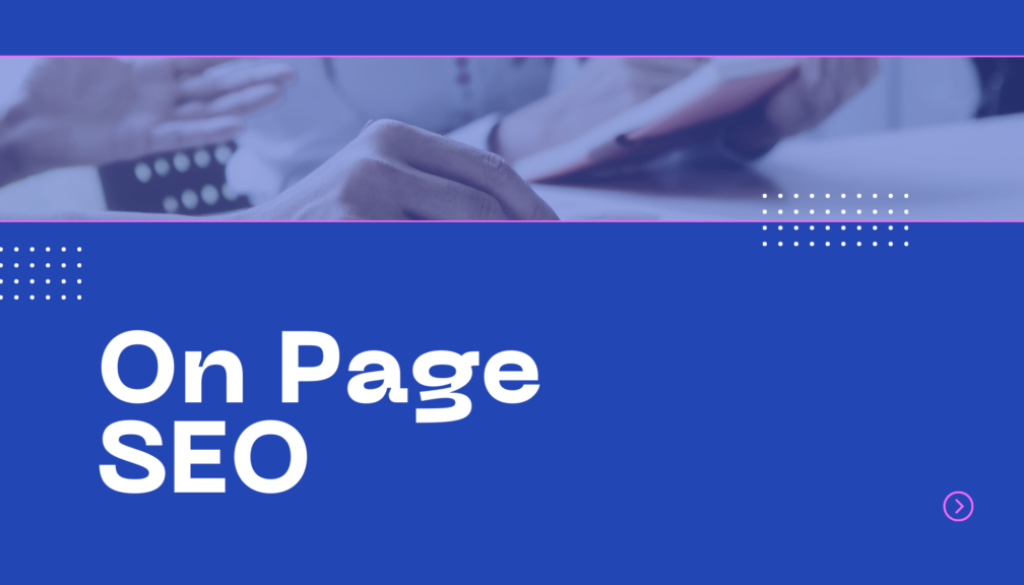What is On Page SEO? : A Complete Guide TO On Page Optimization
In the dynamic digital marketing landscape, On Page SEO is a critical element dedicated to the detailed refinement of individual web pages. It aims to enhance their position in the search engine hierarchies, thus attracting a more relevant and larger audience from these online search platforms. Various fundamental aspects support this complex procedure, each playing an essential role in the comprehensive SEO strategy of a website. An in-depth exploration of these aspects is presented below:
Elements of Content
Exemplary Content
Essence: The cornerstone of On-Page SEO is the generation of content that is innovative and of considerable value and thoroughly engages the audience.
Impact: Content of outstanding quality attracts users and stimulates their interaction with the site, highlighting its relevance and value to search engines.
Keyword Optimization
Essence: The strategic integration of relevant keywords into your content, covering titles, headings, and the main text, is vital.
Impact: Skillful keyword integration aids search engines in understanding and appropriately ranking your content.
Content Structure
Essence: The arrangement of content using headings (H1, H2, H3, etc.) makes it user-centric.
Impact: A carefully structured content layout improves legibility and navigation, benefiting the user experience and SEO.
Elements of HTML
Title Tags
Essence: Each page should feature a unique and insightful title.
Impact: Title tags significantly shape search engines’ perception of the page’s content.
Meta Descriptions
Essence: The art of crafting concise yet persuasive meta descriptions that summarize the essence of page content.
Impact: While not directly influencing rankings, these descriptions affect the click-through rates in search results.
Header Tags
Essence: Appropriate use of header tags effectively organizes and highlights content.
Impact: Headers make the content more understandable and appealing for search engines and readers.
Image Alt Text
Essence: Providing descriptive alt text for images enhances SEO and improves accessibility.
Impact: Alt text enables search engines to interpret images’ content, improving accessibility for users with visual challenges.
URL Structure
Descriptive URLs
Essence: Crafting URLs that are descriptive and integrate relevant keywords.
Impact: These URLs simplify the process of search engine crawling and are more user-friendly.
URL Length
Essence: Maintaining concise URLs while avoiding unnecessary parameters.
Impact: Shorter URLs are easier to read and share and generally more beneficial for SEO.
Internal Linking
Linking Strategy
Essence: Establishing a network of internal links for seamless navigation and effective distribution of page authority.
Impact: Internal links strengthen the site’s structure, aiding search engines and users in navigating the site.
Site Architecture
Mobile-Friendliness
Essence: Ensuring the website’s flawless functionality across various mobile devices.
Impact: Mobile adaptability is crucial for the user experience and a critical factor in search engine rankings.
Site Speed
Essence: Optimizing the site for rapid loading.
Impact: Quicker loading times enhance the user experience and positively influence your site’s ranking in search engines.
SSL/HTTPS
Essence: Implementing secure and encrypted web connections.
Impact: Secure sites are favored by both search engines and users, impacting trust and SEO.
User Experience (UX)
Navigation
Essence: Develop clear and intuitive navigation for your website.
Impact: User-friendly navigation leads to more extended visits, reducing bounce rates and sending positive signals to search engines.
User Engagement
Essence: Creating web pages that actively engage and captivate users.
Impact: High user engagement can lead to higher conversion rates and content sharing, indirectly benefiting SEO.
Rich Snippets/Structured Data
Schema Markup
Essence: Applying structured data to help search engines understand the context of your pages.
Impact: This can result in rich snippets in search results, increasing visibility and click-through rates.
Page Performance and Accessibility
Page Load Speed
Essence: Ensuring fast loading of pages.
Impact: Loading speed is a direct ranking factor and significantly affects the user experience.
Accessibility
Essence: Making the website accessible to all users, including those with disabilities.
Impact: Accessibility expands your audience reach and can positively influence SEO.
Social Tags
Open Graph Tags and Twitter Cards
Essence: Utilizing these tags to control content display on social platforms.
Impact: Well-designed social tags can increase the likelihood of shared content and drive traffic, indirectly aiding SEO.
Content Freshness
Regular Updates
Essence: Continually updating and maintaining the relevance of content.
Impact: Search engines prefer fresh, current content, which keeps users engaged and returning.
Canonical Tags
Avoiding Duplicate Content
Essence: Using canonical tags to specify the preferred version of a webpage.
Impact: This prevents issues with duplicate content, ensuring that search engines index and rank the correct page.
Conclusion
In summation, On-Page SEO is the linchpin in the grand tapestry of digital marketing, weaving together a confluence of creativity and analytical precision. It’s not merely a procedural task but a dynamic interplay of various elements that, when harmonized, can transform a website into a beacon for relevant audiences, elevating its stature in the digital echelons and fostering a robust user connection.
